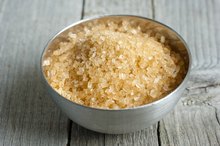Negative Side Effects of Maltitol
Maltitol is a sugar alcohol -- a type of carbohydrate used as an ingredient in many no-sugar-added and sugar-free foods. These compounds resemble both sugar and alcohol but do not contain ethanol --which is found in alcoholic beverages. Because sugar alcohols are incompletely digested, these sugar alternatives provide fewer calories per gram and impact blood sugar less when compared to other dietary carbohydrates. But this incomplete digestion can lead to gas, bloating and diarrhea, particularly if large amounts are consumed.
Gastrointestinal Side Effects
When maltitol and other sugar alcohols, also called polyols, reach the large intestines, they are fermented by gut bacteria, which produces gas and bloating. The presence of these unabsorbed sugars in the gut also attracts water, and this may cause loose stools or diarrhea. These side effects can affect anyone, but small children and people with gastrointestinal conditions such as irritable bowel syndrome may be particularly sensitive to the side effects of sugar alcohols.
Dosing to Curtail Side Effects
How Many Grams of Sugar Per Day Can a Diabetic Have?
Learn More
The amount of maltitol that is tolerated without gastrointestinal side effects may vary person to person, but one study suggested up to 50 grams of maltitol produced no symptoms in healthy adult volunteers. Since just a few servings of maltitol-containing candy can exceed this 50-gram mark, it's important to keep an eye on portions in order to avoid side effects. Because of these known side effects, foods marketed as "sugar free" or "no added sugar" -- and sweetened with sugar alcohols -- must include the type and amount of polyols on the Nutrition Facts panel, and bear the statement "Excess consumption may have a laxative effect."
Blood Sugar Impact
Because maltitol and other polyols do not get fully digested and absorbed, they raise blood sugar less when compared to other dietary sugars and starches. As a result, foods sweetened with polyols are commonly marketed to people with diabetes. However, due to their reduced blood sugar impact, people who take insulin based on their carbohydrate intake may need a lower insulin dose when consuming polyol-sweetened foods. The American Diabetes Association recommends an adjustment to the carbohydrate count be made to account for this reduced blood sugar impact, by subtracting half of the sugar alcohol or polyol grams from the total carbohydrate grams 4.
- Because maltitol and other polyols do not get fully digested and absorbed, they raise blood sugar less when compared to other dietary sugars and starches.
- As a result, foods sweetened with polyols are commonly marketed to people with diabetes.
Warnings
Foods Containing Glucose or Fructose
Learn More
If you choose to consume foods or beverages sweetened with maltitol or other polyols, read the food labels to ensure you are consuming moderate portions. Use these products with caution, if at all, in the diets of children as they will not tolerate the same quantities that adults do. Polyol tolerance varies from person to person, so if you suffer side effects even with small portions of these foods, it's best to avoid products sweetened with these sugar alternatives. If you have diabetes, talk with your dietitian or certified diabetes educator about the use of sugar alcohols in your diabetes meal plan.
Reviewed by Kay Peck, MPH RD
- If you choose to consume foods or beverages sweetened with maltitol or other polyols, read the food labels to ensure you are consuming moderate portions.
- Polyol tolerance varies from person to person, so if you suffer side effects even with small portions of these foods, it's best to avoid products sweetened with these sugar alternatives.
Related Articles
References
- European Journal of Clinical Nutrition: A Digestive Tolerance Study of Maltitol
- International Journal of Food Sciences and Nutrition: Short-Term Digestive Tolerance of Chocolate Formulated with Maltitol in Children
- International Food Information Council Foundation: Sugar Alcohols Fact Sheet
- Diabetes Care: Nutrition Recommendations and Interventions for Diabetes: A Position Statement of the American Diabetes Association
- Rodríguez trabado A, Cámara hijón C, García-trujillo JA, Magriz trascón I, Fernández pereira LM. A Case of Immediate Hypersensitivity Reaction to Maltitol. Case Rep Med. 2017;2017:2127167. doi:10.1155/2017/2127167
- Wiebe N, Padwal R, Field C, Marks S, Jacobs R, Tonelli M. A systematic review on the effect of sweeteners on glycemic response and clinically relevant outcomes. BMC Med. 2011;9:123. doi:10.1186/1741-7015-9-123
- Keijser BJF, Van den broek TJ, Slot DE, et al. The Impact of Maltitol-Sweetened Chewing Gum on the Dental Plaque Biofilm Microbiota Composition. Front Microbiol. 2018;9:381. doi:10.3389/fmicb.2018.00381
- Dhar V, Tinanof N. Update on Sugar Alcohols and Their Role in Caries Prevention. Decisions in Dentistry. 2016;2(7):44–47.
- Keukenmeester RS, Slot DE, Rosema NA, Van loveren C, Van der weijden GA. Effects of sugar-free chewing gum sweetened with xylitol or maltitol on the development of gingivitis and plaque: a randomized clinical trial. Int J Dent Hyg. 2014;12(4):238-44. doi:10.1111/idh.12071
- Mäkinen KK. Gastrointestinal Disturbances Associated with the Consumption of Sugar Alcohols with Special Consideration of Xylitol: Scientific Review and Instructions for Dentists and Other Health-Care Professionals. Int J Dent. 2016;2016:5967907. doi:10.1155/2016/5967907
- Ashwell M. Stevia, Nature's Zero-Calorie Sustainable Sweetener: A New Player in the Fight Against Obesity. Nutr Today. 2015;50(3):129-134. doi:10.1097/NT.0000000000000094
- Maltitol. National Center for Biotechnology Information.
- Sugar Alcohols. U.S. Food and Drug Administration.
- Maltitol. Diabetes UK.
- Chattopadhyay, S., Raychaudhuri, U., & Chakraborty, R. (2011). Artificial sweeteners - a review. Journal of Food Science and Technology, 51(4), 611-21. doi: 10.1007/s13197-011-0571-1
- Maltitol. Science Direct. Encyclopedia of Food Chemistry, 2019
- Office of Federal Register, General Services Administration, Code of Federal Regulations. Title 21, Section 101, Food Labeling: Health Claims; Sugar Alcohols and Dental Caries.
- Vineet Dhar, BDS, MDS, PhD and Norman Tinanoff, DDS, MS. Update on Sugar Alcohols and Their Role in Caries Prevention. Journal of Multidisciplinary Care Decisions in Dentistry. July 1, 2016
- Kearsley, MW, Boghani, N. Maltitol. In: Alternative Sweeteners. 4th ed. Boca Raton, FL: CRC Press; 2012.
Writer Bio
Jamie Simpson is a researcher and journalist based in Indianapolis with more than 10 years of professional writing experience. She earned her B.S. in animal science from Purdue University and her Master of Public Affairs in public management from Indiana University. Simpson also works as a massage therapist and equine sports massage therapist.









